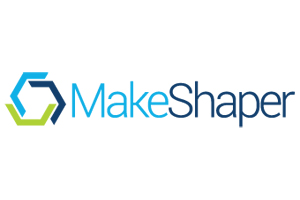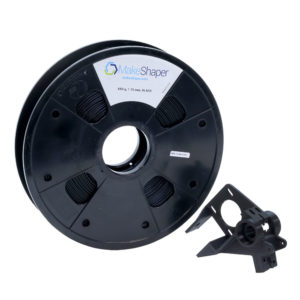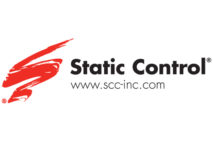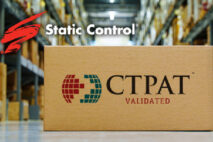 Last year, Static Control launched its MakeShaper division, which produces filaments, supplies, and cartridges for fused deposition modeling (FDM) 3D printers. It’s a tough market to crack. There are almost as many manufacturers of FDM filament as there are OEMs—hundreds. Only a dozen or so non-OEM brands have established themselves with a good color and material selection of high-quality filament. Most of them are based in Asia.
Last year, Static Control launched its MakeShaper division, which produces filaments, supplies, and cartridges for fused deposition modeling (FDM) 3D printers. It’s a tough market to crack. There are almost as many manufacturers of FDM filament as there are OEMs—hundreds. Only a dozen or so non-OEM brands have established themselves with a good color and material selection of high-quality filament. Most of them are based in Asia.
Static Control is not the first 2D aftermarket supplies company to produce consumables for the 3D printing market. It is unique, however, in that its MakeShaper filaments are developed and manufactured in the United States. That and a focus on quality control should give it a leg up, at least in the U.S. market.
MakeShaper’s July announcement of a new flexible thermoplastic polyurethane (TPU) filament with adapters is a good indicator that the company has the engineering know-how to compete. Taking on the development of a flexible filament is a brave decision. Flexible filaments are known to not feed well through the extruder or produce poor-quality prints.
Flexible filaments produce objects that can be bent or crushed and then return to their original shapes. MakeShaper developed its flexible filament in response to a request from a business that required an FDA-compliant material but was getting poor results from other sources. The company was able to leverage its in-house engineering and material science know-how to develop the filament. During the development, it became apparent for the need of an adaptor on certain printers in order to properly use flexible filament. MakeShaper has used its experience developing chipsets and components for traditional printer cartridges to develop fully legal, chipped filament cartridges for the 3D Systems Cube line of printers, the only company to do so.
MakeShaper also provides refill kits for the popular XYZprinting Da Vinci line of printers. In addition to the flexible TPU filaments, MakeShaper sells acrylonitrile-butadiene-styrene (ABS) and polylactic acid (PLA) filaments in spool and stick form and in multiple colors.
“The 2D space is a fully mature industry,” said Erica Edwards, sales manager at MakeShaper. “3D is new and exciting. We want to take everything we’ve learned in 2D to the 3D market. We hope it will mimic the 2D market in growth.”
Market Strategy
Again, it’s hard for a manufacturer of FDM filament to get attention in the market. MakeShaper has some real advantages and seems to be taking the right steps to make an impact. “We have our own engineers and material scientists, and we have the resources of Static Control marketing,” said Ms. Edwards. “All those are important pieces of the puzzle.” She also cited Static Control’s reputation for providing top-notch customer service as an asset to MakeShaper.
MakeShaper sells its filaments directly through its website and an internal sales team. It is also working with some resellers, and its products are available through Amazon and Supplies Network.
A prime focus is on 3D printer OEMs. “We want to reach out to every OEM and let them test and sample [our product],” said Ms. Edwards. MakeShaper filament is currently shipped with some printers. “It would be ideal if we become the OEM’s brand,” she added. Such deals have proven to be big credibility builders and boost sales volumes, particularly in the form of replenishment sales.
The company is targeting both consumer and professional users. There are key differences between those two markets. Consumers are more likely to experiment with third-party filaments, especially if they can get interesting colors or material qualities. They are cost-conscious, but willing to risk print malfunctions for the sake of experimenting.
Of course, the professional market cares about cost, but it is more risk adverse. Losing hours of work due to a bad print costs much more than saving a few dollars on a spool of filament. Professional users also tend to have very specific material and color needs, and sometimes that limits their supplier options.
This is why having a viable flexible TPU filament is important to MakeShaper. It appeals to the creative side of consumers, and it has many applications on the professional side.
MakeShaper has a reasonably good color selection of PLA and ABS in both 1.75 mm and 2.85 mm diameters in a wide range of spool sizes and filament sticks. The Cube cartridges and the FDA-compliant flexible TPU are good differentiators. Ms. Edwards said that the company is also working on some more exotic filaments to further expand MakeShaper’s offerings and co-development projects.
Perhaps most important, MakeShaper is open to working with both customers and OEMs to develop materials to fit a specific need. “At the end of the day, we are solutions oriented,” said Ms. Edwards. “We will work with customers to develop solutions and solve problems.”
Our Take
Both the consumer and professional markets are leery of any new filament provider. Quality varies significantly from supplier to supplier, and both consumer and professional users want to feel confident that a filament will produce good results without damaging their equipment.
MakeShaper, with Static Control’s 30-year history of developing and manufacturing components and materials, can make a strong case as a dependable filament provider. The company seems to have a robust quality-control program both during and after production, and the “made in USA” angle will carry weight with consumers and some OEMs.
We also agree with MakeShaper’s expectation that 3D printers, FDM models in particular, will find their way into many homes and offices over the next few years. At the low end, prices are dropping while quality and ease of use are improving. The industry has also started to take step to make 3D printers more environmentally safe. All that will drive demand for consumables.
This is what Ms. Edwards meant when she said she hoped the 3D market growth would mimic that of the 2D market. By comparison, the 3D market is where the 2D market was in the late 1970s or early 1980s. That makes it a good time for a company like MakeShaper to establish itself in the market.





